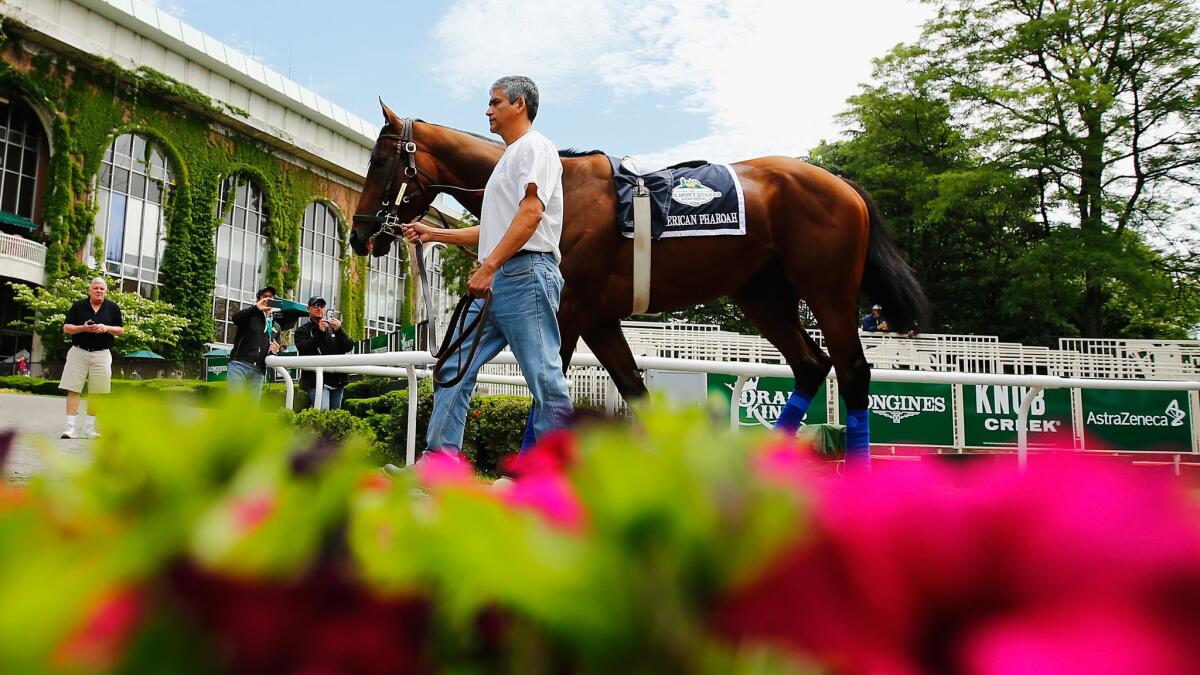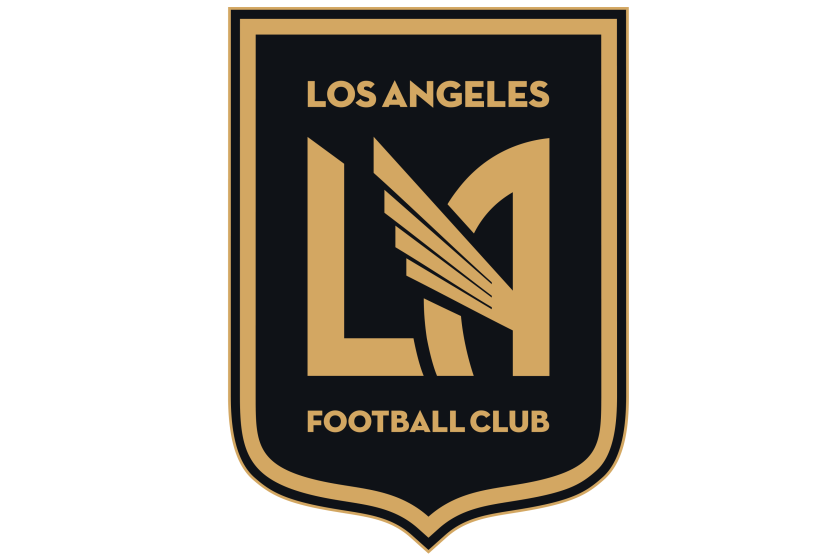Column: Strange week for horse racing, from the Belmont to Hollywood Park

American Pharoah is led through the paddock at Belmont Park on Thursday.
- Share via
FROM ELMONT, N.Y. — We are two days from the 147th running of the Belmont Stakes, horse racing’s most recent attempt at finding its Fountain of Youth. If American Pharoah finally gets a Triple Crown for the sport, they can erect a statue of Ponce De Leon in the infield.
Sometimes, racing feels more like a giant contradiction than a common-sense equine athletic endeavor.
The regular racing program Thursday at Belmont Park drew dozens. With a huge moment only 48 hours away, you needed to find some beehives to get any buzz.
They built this place for mammoth days — by one calculation, you could fit 48 football fields into the infield — and they will get one Saturday.
But the thrill of anticipation and the agony of cavernous silence are hard to reconcile.
Thursday, the most excitement came when a filly named Tonasah tossed her rider, Javier Castellano, in the parade to the gate for the third race, and it took outriders nearly 10 minutes to corner her and clear the track.
That left the race, which had a $250,000 purse, with just four horses — all lightly tested and unpredictable 2-year-old babies. It also likely left gamblers wondering what was the point.
As the big headlines for the upcoming Belmont stand dark and dominant, the sport’s gray areas continue to cast shadows. For every Bob Baffert quote and sincere effort of those involved in this almost-desperate attempt for the sport’s 12th Triple Crown winner, there may be a corresponding sad memory of what happened in the same week as American Pharoah’s quest.
On Sunday at 6 a.m., they brought down the grandstand at Hollywood Park. Imploded it in less than 20 seconds.
It was built in 1938, then rebuilt in 1950 after a fire the year before.
It had been the workplace and play place for equine stars and human stars. For every Native Diver, Lava Man and Zenyatta running, there was a Jimmy Stewart, Elizabeth Taylor and Cary Grant watching.
The essences of Breeders’ Cups and Hollywood Gold Cups and Marje Everett and R.D. Hubbard and Harry Ornest and Bill Shoemaker and Laffit Pincay Jr., and hundreds of others were shredded into oblivion with five or six pops of explosives. The grandstand went down, left to right as the cameras faced it looking west.
It folded in sections, much as many in racing fear their sport is.
For years, John Shirreffs trained his horses there. It was home. It was where he prepared Giacomo for his stunning Kentucky Derby victory in 2005, at 50-1 odds. It is where he had Zenyatta hot walked, often as much as two hours a day, to control her energy so she would be on her best behavior for the dozens of visitors that came to pet her nose every day, as she became the most famous horse in the world.
Shirreffs’ entire operation is here now. He has two of the now 11-year-old Zenyatta’s foals, Cozmic One and Ziconic, in training. But part of him, like so many in racing from Southern California, remains at Hollywood Park.
“I did see it [the implosion] on the computer,” Shirreffs said. “I understand that change is inevitable, but I don’t know if Hollywood Park ever realized what it meant to the people living nearby and working there.
“There were 1,500-2,000 horses stabled there. It took at least two people per horse to take care of them. And it gave people who were just coming to this country a chance to get employed, to get their feet on the ground.
“A lot of these people saved their money and sent their kids through college. I wish somebody would have considered their welfare.”
Hubbard sold Hollywood Park in 1999 for $140 million to Churchill Downs. Six years later, Churchill sold it to a land management company. The named description of the new buyer made the future obvious. Also obvious was the motivation for the sale. Bay Meadows Land Company paid Churchill $257.5 million for the Hollywood Park property.
Horse racing had decided its future had a price.
Two years ago last month, the appointed Bay Meadows transition guardian, Jack Liebau, announced that racing would end with the winter meeting of 2013. His announcement included the now famous dagger into the hearts of horsemen: “The land now simply has a higher and better use.”
On the last day of racing, Dec. 22, 2013, a 2-year-old named California Chrome won the King Glorious Stakes.
This week’s coverage of Hollywood Park’s demolition reflected the current media’s general to-hell-with-yesterday-and-hurry-up-to-tomorrow approach to all things. No horsemen were interviewed. Only Rams fans, awaiting their new stadium.
“This is absolutely happening,” said Randy Troy, who needs to understand that nothing about NFL stadium deals is ever “absolutely happening.”
Inglewood Mayor James Butts, wearing a Rams hard hat, was quoted by USA Today as saying, “This will become the development that catapults Inglewood into international prominence.”
Also wrong. Inglewood’s “international prominence” will always be as a sideshow to Los Angeles. If they come back, will the Rams be calling themselves the Inglewood Rams?
Triple Crown time is here. Again. An American Pharoah victory will be a big bump for racing. Happy Hhadlines will scream. Thousands will like what they see, get the bug and join the fun.
But how long will they patronize a sport that had a huge chunk of its legacy publicly blown up in the same week?
Shirreffs wants a Triple Crown. Every horseman does. He is also a realist and deep-thinker.
“You lose one like Hollywood Park, there is a ripple effect,” he said. “It was the best place, the best location, the best climate.
“And they got rid of it.”
Saturday can bring joy. It cannot bury rubble.
More to Read
Go beyond the scoreboard
Get the latest on L.A.'s teams in the daily Sports Report newsletter.
You may occasionally receive promotional content from the Los Angeles Times.











